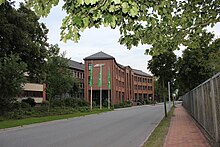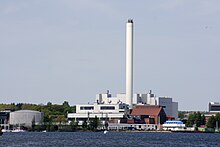Stadtwerke Flensburg
Coordinates: 54 ° 48 ′ 18.3 " N , 9 ° 25 ′ 48.3" E
| Stadtwerke Flensburg GmbH
|
|
|---|---|
| legal form | GmbH |
| founding | 1854 |
| Seat | Flensburg , Germany |
| management |
|
| Number of employees | 656 (2019) |
| sales | € 442 million (2019) |
| Branch | energy |
| Website | www.stadtwerke-flensburg.de |
The Stadtwerke Flensburg are a utility company of the city of Flensburg based on Flensburg Harbor . The company is active in Flensburg in the business areas of electricity, district heating, drinking water and industrial gas supply as well as (broadband) telecommunications. To liberalize the electricity market in Germany in 1998, Stadtwerke Flensburg began selling electricity across Germany.
Network connection to the Danish network
The grid area of Stadtwerke Flensburg is a special case in the German energy system. Because of the direct connection to the Danish power grid at the 60 kV and 150 kV level, it is technically part of the control area of the Danish transmission system operator energinet.dk and not the control area of the north-west Germany’s responsible transmission system operator TenneT TSO . The connection to the German power grid, which has a phase shift of 180 degrees compared to the Danish power grid, is made by a helical regulating transformer with galvanic isolation (combination of series control (usually step switch ) and cross control (with a phase shift transformer )). Flensburg is thus a virtual control area in Denmark, but participates in the market rules in Germany. Stadtwerke Flensburg has been assigned the market roles of a transmission system operator and a balance sheet coordinator for market communication .
Nationwide electricity and gas provider
Stadtwerke Flensburg is a large nationwide electricity and gas provider for private and business customers. They sell 80 percent of their electricity outside the actual sales area of Flensburg and the surrounding area.
With Flensburg eXtra eco and green electricity from 100% hydropower is offered, the by TÜV-Nord declared with the environmental protection certificate and with the ok-power label is signed.
history
Gas supply began in Flensburg in 1854, initially producing coal gas from the gas works in Gasstrasse, and from 1910 in the gas works in Batteriestrasse. In 1963 the company switched to butane gas production. In 1982 the old town gas supply was shut down. There has only been a natural gas supply for individual industrial customers since 1988.
The central water supply in Flensburg began in 1881. In the years 1894–1913, the Ostseebad waterworks went into operation , which was supplemented by the second southern waterworks from 1970.
In 1894 the electricity supply in Flensburg began with the direct current electricity works in Karlstraße. In 1913, today's power plant on Strandweg was put into operation. Since 1928 the Flensburg power plant has been working together with the power plant in Aabenraa in Denmark in the field of electricity supply. Due to the liberalization of the electricity market and the termination of electricity production in Aabenraa, the cooperation was recently terminated. During the air raids on Flensburg , the municipal supply infrastructure was also damaged, so that parts of it were temporarily out of order.
Thermal power station
In the period from 1969 to 1971, the Flensburg power plant was converted into a thermal power plant . During this renovation period, the supply of Flensburg with district heating was ensured via provisional mobile heating centers in Flensburg districts (see there ). In the following years the district heating network was further expanded. Since 1983 there has been a cross-border district heating supply to nearby Padborg in Denmark.
Conversion to other energy sources
Since 2008, in addition to the main fuel, hard coal , secondary fuels and small amounts of wood chips have been used as fuels; a proportion of substitute fuels of up to 25% is technically possible. Around half of the secondary fuels and wood chips are considered renewable energy sources , which means that 30,000 to 40,000 t of CO 2 are saved per year. Under the slogan greenco2ncept , the Stadtwerke Flensburg want to become CO 2 -neutral by 2050 .
With the construction of "Boiler 12" and "13" four of five coal boilers will be shut down, the last remaining one will be able to retire in a few years, and thus significantly earlier than the coal phase-out planned by the federal government in 2038. With the two With natural gas-operated boilers, the Flensburg heat supply is covered by up to natural gas, which emits significantly less CO 2 than coal.
Boiler 12
From 2011 to 2015 “Boiler 12” was modernized by the thermal power station for around 128 million euros. It was the largest single investment by the Stadtwerke in more than 25 years. In April 2016, the gas and steam turbine system ( CCG for short ) was put into operation with an efficiency of over 90%, which replaced two old coal boilers with 80%. The plant has an output of around 75 megawatts (MW) thermally and around 75 MW electrically. Their overall efficiency of 92 percent is around ten percent higher than the old overall efficiency of the thermal power station. By replacing coal with natural gas, CO 2 emissions are reduced by around 40 percent with the same amount of energy produced , and additional variability in electricity production is gained. This compensates for the limited controllability of renewable energy sources and produces short-term electricity whenever there is not enough available on the market.
Boiler 13
With the construction of "Kessel 13", another natural gas-powered combined heat and power plant ( CHP ), the modernization of the Flensburg thermal power station is to continue. The plant is to go into operation in 2022 with a district heating output of 70 megawatts and replace two more coal boilers. From a technical point of view, these should continue to operate for up to ten years, but will be switched off shortly after commissioning. This will reduce CO 2 emissions by 40% while generating the same amount and save up to 120,000 t CO 2 annually , with investment costs of around 95 million euros.
Electric hot water boiler
In January 2013, an electrode hot water boiler with an output of 30 MW was put into operation at the Batteriestraße location , the costs amounted to 2 million euros. If there is a lot of wind blowing or the sun is shining, a lot of renewable electricity is fed into the grid, then the merit order effect means that the electricity market price is cheap or even has a negative value. With this cheap electricity, the district heating water is heated, "temporarily stored" in a 29 million liter boiler and then used for the local district heating supply. This process is known as power-to-heat . In some parts of Germany, especially in northern Schleswig-Holstein, wind turbines have to be reduced in output or taken off the grid during storm phases . Therefore z. For example, in 2010 a total of approx. 150 GWh of electrical energy were not fed in, which corresponds to around 0.4% of the total wind power feed-in this year (approx. 37.8 TWh). By “heating” the actually high-quality electricity to low-quality heat, the forced shutdown of wind turbines can be reduced, and the primary energy requirement of conventionally operated boilers is also reduced.
Sewage network
In 2015, the municipal utilities made efforts to relocate the sewage network including the sewage treatment plant and the corresponding employees from the technical operations center to the municipal utilities. This met with rejection from the workforce of the TBZ and the city council group DIE LINKE, which is why this step was not taken.
Heat monopoly and compulsory connection
Because of the monopoly, around 98% of all Flensburg residents are supplied with district heating from the combined heat and power generation from the Flensburg thermal power station.
The costs for this have tripled in the last 20 years, while the electricity costs "only" doubled.
Stadtwerke Flensburg filed a lawsuit against an investigation by the Federal Cartel Office. After the judicial defeat, the requested data was delivered and it turned out that "the district heating prices 2007/08 were among the cheapest in Germany."
Participations and shareholders
The city of Flensburg is the sole shareholder of the company.
Stadtwerke Flensburg is involved in various companies. Sole owned subsidiaries are Aktiv Bus Flensburg GmbH (ÖPNV), AWZ Abfallwirtschaftszentrum Flensburg GmbH , Flensburger Hafen GmbH and Flensburger Flughafenbetriebsgesellschaft mbH from the Flensburg-Schäferhaus airport . In addition, there is the minority stake in the municipal offshore wind park Borkum Trianel Windkraftwerk Borkum GmbH & Co.KG with 6%. The company has a 2.7% stake in NSH Nahverkehr Schleswig-Holstein through Aktiv Bus .
In order to concentrate on the core business, investments in TRIGIS GmbH and Semeco GmbH have been sold in recent years . The Flensburger Förde Energie GmbH and the IT consulting company IT-Power GmbH were dissolved in 2015.
The Stadtwerke had been operating the Flensburg campus pool, built in 2010 through Förde Bäder GmbH, since 2013, and this was transferred to the TBZ in mid-2019.
Web links
Individual evidence
- ↑ Stadtwerke Flensburg ,: market communication, information on business processes. Retrieved May 13, 2020 .
- ↑ Code allocation portal of Energie Codes und Services GmbH - on behalf of BDEW. Retrieved May 12, 2020 .
- ^ Joachim Pohl: Stadtwerke: Electricity flushes millions to Flensburg | shz.de. In: SHZ. May 23, 2015, accessed December 30, 2019 .
- ↑ a b Archived copy ( Memento of the original from May 22, 2013 in the Internet Archive ) Info: The archive link was inserted automatically and has not yet been checked. Please check the original and archive link according to the instructions and then remove this notice. , Stadtwerke Flensburg, accessed on November 7, 2013.
- ↑ greenco2ncept ( memento of the original from January 15, 2012 in the Internet Archive ) Info: The archive link has been inserted automatically and has not yet been checked. Please check the original and archive link according to the instructions and then remove this notice. . Website of the Stadtwerke Flensburg. Retrieved January 28, 2012.
- ^ Electrode boilers - Stadtwerke Flensburg put electric heating into operation . Website of the Stadtwerke Flensburg. Retrieved February 21, 2013.
- ↑ Stadtwerke will soon be heating with free electricity . In: Flensburger Tageblatt , January 28, 2012. Accessed March 7, 2017.
- ↑ Systems are being switched off more and more often . In: Sonne Wind und Wärme , November 2, 2011. Retrieved January 28, 2012.
- ^ Joachim Pohl: Stadtwerke: Flensburg's networks remain in different hands | shz.de. SHZ, November 26, 2015, accessed December 30, 2019 .
- ↑ a b Joachim Pohl: Steep rise in heating costs | shz.de. SHZ, July 4, 2016, accessed December 30, 2019 .
- ^ Stiftung Warentest: Prices for district heating - providers under suspicion - Stiftung Warentest. Accessed December 30, 2019 .
- ↑ https://www.stadtwerke-flensburg.de/fileadmin/_migrated/content_uploads/geschaeftsbericht-swfl-2013_01.pdf
- ↑ Our daughters & holdings. Stadtwerke Flensburg, September 2019, accessed on December 30, 2019 .
- ↑ Council meeting in Flensburg: TBZ takes over the campus pool | shz.de. June 2019, accessed December 30, 2019 .
- ^ Resolution of the Flensburg council meeting: Campus pool will be located at the TBZ in the future. In: AKOPOL - Local Policy Working Group. June 28, 2019, accessed December 30, 2019 (German).





